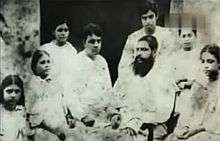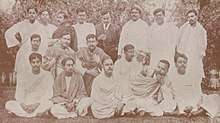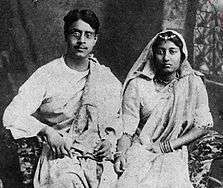Sukumar Ray
| Sukumar Ray | |
|---|---|
 | |
| Native name |
সুকুমার রায় (তাতা) |
| Born |
Suku 30 October 1887 Calcutta, Bengal Presidency, British India |
| Died |
10 September 1923 (aged 35) Residence, Garpar in North Calcutta, British India |
| Language | Bengali |
| Nationality | British Indian |
| Alma mater |
Presidency University, Kolkata London College of Communication |
| Period | Bengal Renaissance |
| Genre | Literary nonsense |
| Notable works | Abol Tabol, Pagla Dashu, HaJaBaRaLa |
| Spouse | Suprabha Devi |
| Children | Satyajit Ray (son) |
| Relatives | Upendrakishore Ray (father) and Bidhumukhi Devi (mother) |
Sukumar Ray (Bengali: সুকুমার রায়, ![]()
Early years
Sukumar Ray was born in a Brahmo family in Calcutta, India on 30 October 1887. His family was hailed from Masua village of Mymensingh division of Eastern Bengal and Assam in British India, presently in Bangladesh.[2] Sukumar's father Upendrakishore Ray was a famous Bengali writer, painter, violin player and composer, technologist, amateur astronomer and entrepreneur.[3] Sukumar's mother Bidhumukhi Devi was daughter of Dwarkanath Ganguly.[4]

Born in the era which can be called the pinnacle of the Bengal Renaissance, he grew up in an environment that fostered his literary talents. His father was a writer of stories and popular science; painter and illustrator; musician and composer of songs; a technologist and hobbyist astronomer. Upendrakishore was also a close friend of Rabindranath Tagore, who directly influenced Sukumar. Among other family friends were Jagadish Chandra Bose, Prafulla Chandra Roy, Atul Prasad Sen etc. Upendrakishore studied the technology of blockmaking, conducted experiments, and set up a business of making blocks. The firm M/s U. Ray & Sons, where Sukumar and his younger brother Subinay were involved. His sister, Shukhalata Rao, became a social worker and children's book author. Like his father, Ray also had a close acquaintance with Rabindranath Tagore.[5]
Education and Profession

First row sitting from left: Subinoy Ray, Prasanta Chandra Mahalanobis, Atul Prasad Sen, Shishir Kumar Datta, Sukumar Ray
Middle row from left: Jatindranath Mukhopadhyay, Amal Home, Suniti Kumar Chattopadhyay, Jibanmoy Roy
Standing from left: Hiran Sanyal, Ajit Kumar Chakrabarty, Kalidas Nag, Pravat Chandra Gangoadhyay, Dr. Dwijendranath Maitra, Satish Chandra Chattopadhyay, Shrish Chandra Sen, Girija Shankar Roy Choudhury
In 1906, Ray graduated with double Honours in Physics and Chemistry from the Presidency College, then affiliated with the University of Calcutta. Before that he attended City College School, Surya Sen Street along with his classmate, famous funny character "Pagla Dashu" appeared in several of his penned story. He was trained in photography and printing technology in England at the School of Photo-Engraving and Lithography, London,[6] and was a pioneer of photography and lithography in India. While in England, he also delivered lectures about the songs of Rabindranath before Tagore won the Nobel Prize. Meanwhile, Sukumar had also drawn acclaim as an illustrator. As a technologist, he also developed new methods of halftone blockmaking, and technical articles about this were published in journals in England. The Penrose Annual published two articles by Ray. While in the United Kingdom he joined the Royal Photographic Society in 1912 and remained a member until his death, gaining his Fellowship in 1922.[7]

Upendrakishore started a publishing firm, U. Ray and Sons, which Sukumar and Subinay helped to run. While Sukumar went to England to learn printing technology, Upendrakishore purchased land, constructed a building, and set up a printing press with facilities for high-quality halftone colour blockmaking and printing. He launched the children's magazine, "Sandesh", in May, 1913.[1] Very soon after Sukumar's return from England his writings and sketches started appearing in Sandesh. After Upendrakishore died on 20 December 1915, Sukumar ran the printing and publishing businesses and the Sandesh for about eight years. His younger brother Subinoy helped him, and many relatives pitched in writing for "Sandesh".[3]
Sukumar Ray was also known as the convener of "Monday Club" (Bengali: মণ্ডা ক্লাব), a weekly gathering of like-minded people at the Ray residence, where the members were free to express their opinions about the world at large. A number of poems were penned by Sukumar Ray in relation to the matters concerning "Monday Club", primarily soliciting attendance, announcing important meetings etc.
Sukumar Ray was also a leader of the reformist wing in the Brahmo Samaj. Sukumar Ray wrote a long poem "Atiter Katha" (Bengali: অতীতের কথা), which was a popular presentation of the history of the Brahmo Samaj—it was published as a small booklet to introduce the rationale of the Brahmo Samaj to children. Sukumar also campaigned to bring in Rabindranath Tagore, the most famous Brahmo of his time, as a leader of the Samaj.
Sukumar married Suprabha Das, granddaughter of Kali Narayan Gupta (maternal grand father of Atul Prasad Sen) on December 13, 1919, and a family relation thus was developed between Sukumar and Atul Prasad.
Contribution in literature
 Kumropatash in Abol Tabol
Kumropatash in Abol Tabol Dashur Kirti
Dashur Kirti- Huko Mukho Hangla
- Kaath Buro
 Abujh
Abujh The King
The King
 Hijibijbij in HaJaBaRaLa
Hijibijbij in HaJaBaRaLa Nyara in HaJaBaRaLa
Nyara in HaJaBaRaLa Udo in HaJaBaRaLa
Udo in HaJaBaRaLa The Court Room in HaJaBaRaLa
The Court Room in HaJaBaRaLa Shri Kakeswar Kuchkuche in HaJaBaRaLa'
Shri Kakeswar Kuchkuche in HaJaBaRaLa' The CAT in HaJaBaRaLa'
The CAT in HaJaBaRaLa'
Sukumar Ray delved into a unique genre of pure nonsense and gibberish, a pioneering work in Bengali literature with a few exceptions, which was none less interesting than its predecessors of Lewis Carrol's Alice in Wonderland. Amazing sense of humor, sharp power of observation and unfathomed wit merged with a profound command on selection of words produced a class of humor which was equally approachable by children as well as the grown ups. Satyajit Ray, in the preface of the first edition of the compilation of Sukumar Ray's complete works in his centenary year, Sukumar Sahitya Samagra, wrote:
"উপেন্দ্রকিশোরের সম্পাদনাকালে সন্দেশে প্রকাশিত সুকুমারের কয়েকটি রচনায় তাঁর সাহিত্যিক বৈশিষ্ট্যের স্পষ্ট ইঙ্গিত পাওয়া যায়। ১৯১৪ সালে বেরোল আবোল তাবোল শ্রেনীর প্রথম কবিতা "খিচুরি"। এই প্রথম সুকুমার সাহিত্যে উদ্ভট প্রানীর আবির্ভাব। এখানে প্রানীর সৃষ্টি হয়েছে ভাষার কারসাজিতে -
হাঁস ছিল সজারু, (ব্যাকরণ মানিনা)
হয়ে গেল হাঁসজারু কেমনে তা জানিনা।এই উদ্ভট সন্ধির নিযমেই সৃষ্টি হল বকচ্ছপ, মোরগরু,গিরগিটিয়া, সিংহরিণ, হাতিমি।[3]"
After his father's death in 1915, Sukumar had to take over responsibility of publication of "Sandesh", and his creativity reached its pinnacle. The 45 limericks in Abol Tabol and many other creations published in Sandesh still amuse the readers of all ages. He created many characters in his prose and poems. Kaath Buro, Tash Goru, Huko Mukho Hangla, Kumro Potash etc. were fictitious characters, though they were very close to our known world. He himself described his works as the product of Kheyal Ros[3] (হঠাৎ ইচ্ছা;ঝোঁক/Wish; Whims; Freak; Fancy).
Death
Sukumar Ray died on 10 September 1923 at his Garpar residence in Kolkata[8] of severe infectious fever, leishmaniasis, for which there was no cure at the time. He left behind his widow and their only child, Satyajit, who was only two years old at that time. Satyajit Ray would later shoot a documentary on Sukumar Ray in 1987, 5 years before his own death.
Works
| Bengali Wikisource has original text related to this article: |
- Abol Tabol (The Weird and the Absurd)
- Pagla Dashu (Crazy Dashu)[9]
- Khai-Khai (Eat-Eat)
- Heshoram Hushiyarer Diary (The diary of Heshoram Hushiyar) (early science fiction parody)[10]
- HaJaBaRaLa (Mumbo-Jumbo)
- Jhalapala O Onanyo Natok (Cacophony and Other Plays)
- Lakkhaner Shoktishel (The Weapon of Lakkhan)
- Chalachittachanchari
- Shabdakalpadrum
- Bohurupi
- Abak Jalpan (Weird Drinking of Water 1914)
- Bhasar Atyachar (Torture of Language 1915)
Bibliography
Bibliography in Bengali about Sukumar Ray's works, in reverse chronological order (newest first).
English Translations of Abol Tabol
- Rhymes of Whimsy - The Complete Abol Tabol, Translated by Niladri Roy, Haton Cross Press, 2017. (This is the only complete translation of all the 53 poems.)
- The Tenth Rasa: An Anthology of Indian Nonsense, edited by Michael Heyman, with Sumanyu Satpathy and Anushka Ravishankar. New Delhi: Penguin, 2007. (This volume includes, among other Indian nonsense texts, several translations of Sukumar Ray by Chattarji, including some that are not in her solo edition of Abol Tabol)
- Abol Tabol: The Nonsense World of Sukumar Ray. Translated by Sampurna Chattarji. New Delhi: Puffin, 2004. (This edition, a partial translation, also has works from Khapchhada, Bohurupee, Other Stories, Haw-Jaw-Baw-Raw-Law, Khai-Khai, and Pagla Dashu)
- The Select Nonsense of Sukumar Ray. Translated by Sukanta Chaudhuri. New Delhi: OUP, 1987. (The standard edition of Abol Tabol translations (partial) for many years)
- Nonsense Rhymes. Translated by Satyajit Ray. Calcutta: Writer's Workshop, 1970. (This volume by the author's son is the slimmest and is difficult to find. Partial translation)
Analytical Works about Abol Tabol
- Rhymes of Whimsy - The Complete Abol Tabol, with Analyses & Commentary by Niladri Roy, Haton Cross Press, 2017. (Contains analyses of all the poems, with explanations of hidden satire)
- Fantastic Beasts and How to Sketch Them: The Fabulous Bestiary of Sukumar Ray, by Poushali Bhadury. (South Asian Review, Vol. 34, No. 1, 2013) (Analytical reviews of some of Sukumar Ray's illustrations that accompanied his poems in Abol Tabol, and how they complement the verse)
- Colonial India in Children’s Literature, by Supriya Goswami. Routledge, 2012. (This volume includes brief analysis of some of the poems in Abol Tabol. It also analyzes other contemporaneous books)
- The World of Sukumar Ray, by Sukanta Chaudhuri in Telling Tales: Children’s Literature in India, Ed. Amit Dasgupta. New Age International Publishers Ltd. Wiley Eastern Ltd. New Delhi, India 1995, 88-96. (Commentary on some of the poems in Abol Tabol)
References
- 1 2 Ray; Sukumar (tr. Chatterjee; Sampurna). Wordygurdyboom!. Penguin Books India. pp. 177–. ISBN 978-0-14-333078-3. Retrieved 3 October 2012.
- ↑ Raychowdhury, Hitendra Kishore (1984). Upendra Kishore O Moshua - Ray Poribaarer Golposholpo. Firma KLM Private Limited. p. 1.
- 1 2 3 4 Ray, Satyajit; Basu, Partha, eds. (1987). Sukumar Sahitya Samagra Centenary Edition. Ananda Publishers Ltd.
- ↑ Sengupta, Subodh Chandra; Basu, Anjali, eds. (1998) [First published 1976]. Sangsad Bāṅgālī Charitābhidhāna (Biographical dictionary) (in Bengali) (4th ed.). p. 67. ISBN 81-85626-65-0.
- ↑ Sarker, Sushanta (2012). "Rao, Shukhalata". In Islam, Sirajul; Jamal, Ahmed A. Banglapedia: National Encyclopedia of Bangladesh (Second ed.). Asiatic Society of Bangladesh.
- ↑ "Sukumar Ray |". .open.ac.uk. Retrieved 3 October 2012.
- ↑ Correspondence with Dr Michael Pritchard, Director-General, of The Royal Photographic Society, 1 December 2013.
- ↑ "LIfe of Sukumar Ray". Freehostia.
- ↑ Amaresh Datta (1987). Encyclopaedia of Indian Literature: A-Devo. Sahitya Akademi. pp. 694–. ISBN 978-81-260-1803-1. Retrieved 3 October 2012.
- ↑ Early Bengali science fiction, Amardeep Singh, lehigh.edu
External links
- Sukumar Ray Kobita
- Complete Sukumar Ray
- "Drighangchu" by Sukumar Ray translation of short story in The Cafe Irreal
| Wikimedia Commons has media related to Sukumar Ray. |